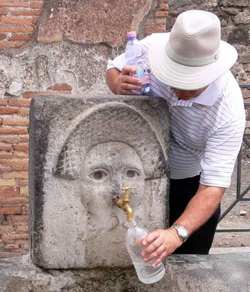 (ANSA) - Rome, June 30 - Italy is sweltering after a heat wave hit the peninsula on Tuesday. The temperature is forecast to climb to up to 37° celsius (98 F ) in parts of Sardinia and the city of Bolzano, although the perceived heat will be as much as 40° (104 F) because of high levels of humidity. The worst-hit areas are predicted to have temperatures around 6° higher than the average for the time of year. For Thursday the health ministry has put the cities of Bolzano, Brescia, Milan and Turin on orange alert for the heat, the second-highest on a scale of three, especially for the elderly, children and people suffering certain illnesses. Basilicata in the south remains a bit cooler than the rest of the country, with some rain expected to give relief from the high temperatures. Italy’s main zoo in Rome offered gelato to its orangutans with a choice of flavors, including fresh fruit and vegetables, or dried figs topped with eggs and insects. The last major hot spell in 2003 caused an estimated 70,000 deaths in Europe, and Portugal has already recorded around 100 deaths over the normal mortality rate since temperatures rose at the weekend, its health authority said.  Keeping cool in a Frigidarium Keeping cool in a Frigidarium Ancient Rome and Heat Waves: The Romans were no strangers to the summer heat. In fact, the modern term: "the dog days of summer”" actually comes from the Latin 'dies canincula', the Roman term used to describe the stuffy, hot period of weather between July and mid-August. The name comes from the fact that Sirius (the dog star) rises with the sun at this time of year, –and Romans thought it was responsible for the increase in temperature. Romans had a secret weapon to beat the heat... The frigidarium. This was a large cold pool at the Roman baths where Romans went to cool down. For the Romans, a daily visit to the baths was an essential social event as much as it was an exercise in personal hygiene. The cold water of the frigidarium was a great place to freshen up after a hard day's toil and was also considered a good way to close your pores after bathing. The waters of the frigidarium were kept chilly in the summer months thanks to the addition of snow and ice that had been imported from the Alps. Romans had another trick up their sleeve that continues in modern Italian culture today... The Ancient Romans did not do a nine-to-five day. In fact, the average Roman only had a six-hour workday, from sunrise until noon. This stopped them from having to labor during the hottest part of the day and left them with plenty of time to go to and sit in the frigidarium with their friends. Sound familiar? The Italians call it riposa... the Italian siesta... the three hour lunch. Stay cool... --Jerry Finzi If you liked this post, please pass it around on your favorite social media site... ciao!
0 Comments
Your comment will be posted after it is approved.
Leave a Reply. |
Categories
All
Archive
June 2024
|


 RSS Feed
RSS Feed
